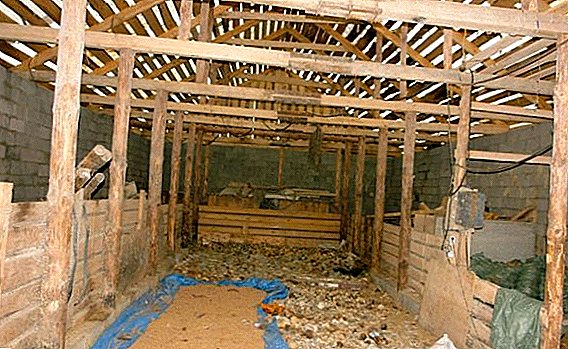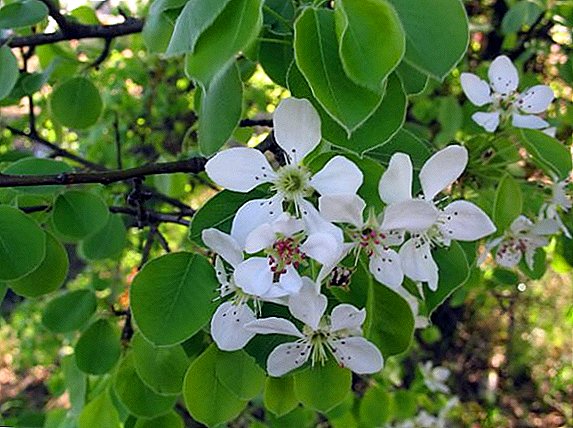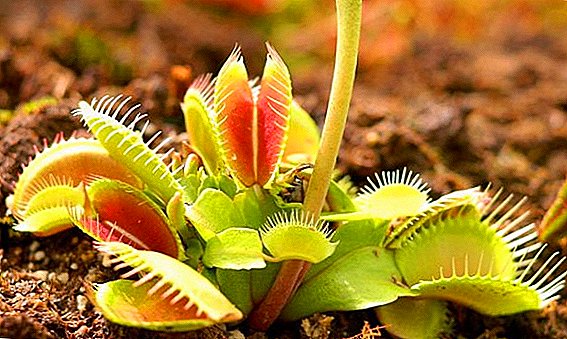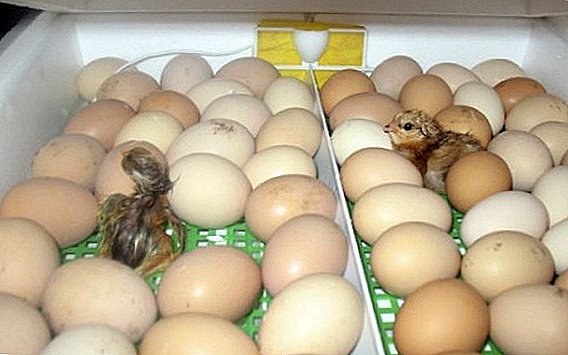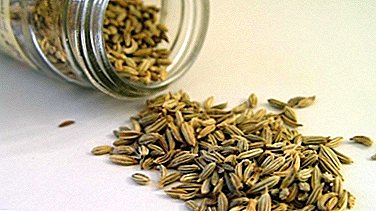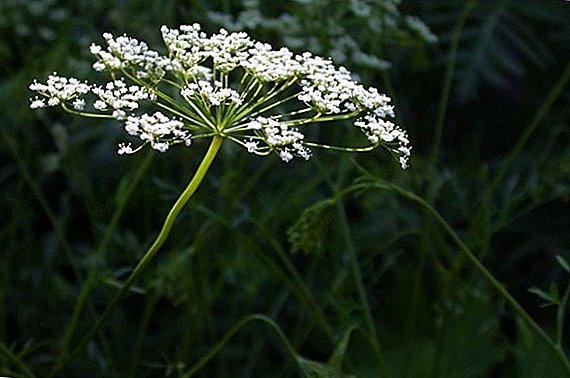 Anise is a versatile plant that has a spicy-sweet and warm aroma. The plant, which is widely used in cooking, pharmacology, cosmetology and traditional medicine, has gained respect for its rich properties among millions of people.
Anise is a versatile plant that has a spicy-sweet and warm aroma. The plant, which is widely used in cooking, pharmacology, cosmetology and traditional medicine, has gained respect for its rich properties among millions of people.
Today, anise is cultivated in almost all countries of the world, it is wild only in Greece. Knowing just a few simple rules, each of us can grow this unique culture.
Did you know? People knew about the existence of anise from antiquity. At that time, in many houses, bundles of anise were tied at the head of the bed to clean the air and prevent nightmares. In the Middle Ages, anise was very valuable and cost a lot of money. For example, in the 14th century in London, money collected from taxes on sales of anise, repaired the Thames Bridge.
Anise ordinary: description
 Anise ordinary (fragrant anise, anise vegetable, anise bedrose) - this is a fragrant annual plant. Got its name from the Greek anison, also the Greeks call it ganij, jire, sweet cumin, bread seed.
Anise ordinary (fragrant anise, anise vegetable, anise bedrose) - this is a fragrant annual plant. Got its name from the Greek anison, also the Greeks call it ganij, jire, sweet cumin, bread seed.
The land of the anise is still not exactly known: some believe that he is from Asia Minor, others from Egypt or the Mediterranean countries. The plant has a straight stem with a height of 60-70 cm and small white umbrella flowers.
Anise is rich in nutrients and trace elements, the description of its chemical composition may envy no less valuable cumin and fennel. It contains a large amount of protein - 19%, up to 23% vegetable fat, up to 3% carbohydrates, sugar, and useful fatty acids, including coffee.
Anis has a wide range of therapeutic action and helps with migraines, bronchitis, asthma, cough, pneumonia, laryngitis, kidney, bladder, flatulence, gastrointestinal diseases, cardiovascular system, and also has a rejuvenating and regenerating effect.
Anise is widely distributed in the food industry, what it is, today they know in almost every home. Even the ancient Romans noticed that anise helps from bloating and flatulence, so they began to add it to almost every heavy dish.
Anise is used in bakery products, desserts, salads, fish and meat dishes. Moreover, if only anise seeds are used for medicinal purposes, then fruits (in desserts), green parts (in salads and side dishes), and seeds are used in cooking. Thanks to the anise, the dishes do not spoil for a long time and do not get stale, keeping the wonderful taste and fragrant aroma.
Important! When used for culinary purposes, do not confuse star anise (star anise) and ordinary anise. These are different plants, although both are spices. They have a similar flavor, but a different look and taste.
How to plant anise, site selection and soil preparation
Now we will take a closer look at how to sow and grow anise at home.
Where to sow anise
 Anis is also a cold-resistant and thermophilic plant, no matter how strange it may sound. Therefore, for good growth of anise, it is best to sow in optimally illuminated places on the southeast and south sides.
Anis is also a cold-resistant and thermophilic plant, no matter how strange it may sound. Therefore, for good growth of anise, it is best to sow in optimally illuminated places on the southeast and south sides.
Anise breeds with the help of seeds that germinate at a temperature of + 5 ... +8 ° C, but the optimum temperature for it is + 20 ... +25 ° C. However, young plants can even transfer a minus temperature to -5 ... -7 ° С.
Ideal for planting places where previously grown vegetables or leguminous plants.
Soil preparation for planting
The site selected for disembarkation needs to be prepared in the fall, before the onset of the first frost: dig 25-30 cm and remove the weeds.
Anise is a rather demanding culture, so its reproduction is best carried out in sandy soils, rich in black soil with a sufficient amount of lime and humus.
Also, anise loves loose soil enriched with phosphorus, which increases the yield and the content of essential oil.
Important! Heavy loamy and swampy soils are not suitable for planting. It is also impossible to plant anise on the place where cilantro used to grow, because they have the same diseases and pests.
Planting anise
 Despite the resistance of the crop to cold weather, it is not worth hurrying with the planting of anise, as cold soil leads to the slow growth of seeds and the development of diseases.
Despite the resistance of the crop to cold weather, it is not worth hurrying with the planting of anise, as cold soil leads to the slow growth of seeds and the development of diseases.
Terms of planting "miracle herbs"
Anise seeds are sown in spring, it may be the end of March - April. At this time, the soil is heated optimally after a frosty winter.
Although in April there are still frosts, it is not scary, anise calmly transfers them. For seed planting it is necessary that the soil warms up, but at the same time remains sufficiently moist.
How to prepare seeds for planting
Seeds grow very slowly due to their dense shell, which does not pass water and air badly, and also because of the high content of essential oil in aniseed fruits.
Seed germination is greatly influenced by soil temperature. If it is rather low (+ 3-4 ° С), then the seeds will germinate by 25-30 days, if it is higher (+ 10-12 ° С), then the first shoots will appear in two weeks.
Before sowing the seeds, they must first be soaked in water with a temperature of + 16 ... +18 ° C for 3-4 hours, changing water every day. Then the seeds need to be wrapped in a damp cloth and hold for another 2-3 days at a temperature of + 18 ... +22 ° С.
 When 4-5% of the seeds begin to germinate, they need to be spread out in a thin layer on a cloth and dried slightly, stirring from time to time. Also, the seeds must undergo partial vernalization in the refrigerator for about 20 days.
When 4-5% of the seeds begin to germinate, they need to be spread out in a thin layer on a cloth and dried slightly, stirring from time to time. Also, the seeds must undergo partial vernalization in the refrigerator for about 20 days.
This is necessary in order to ensure the adaptation of crops in case of a drop or decrease in air temperature, which is often observed in spring. After such preparation, seeds sprout in 10-11 days after planting.
Anise sowing rules
On the same day, when you plan to plant anise, you need to carefully loosen the soil and make superphosphate. To get a good harvest, you need to sow the crop in rows, at a distance of 35-45 cm between them.
The sowing depth is no more than 1.5-2.5 cm. Then the soil is rolled. The vegetation period reaches 150 days. Two weeks after the appearance of the shoots, they should be thinned to a distance of 10-15 cm.
Did you know? Anise well plant near the apiary. This will benefit not only the plant, but also the apiary itself: anise is an excellent honey plant.
What you need to know about anise care
 The plant requires standard care: watering, loosening the soil, feeding and removal of weeds. It is necessary to carefully monitor how the anise grows, as excessive soil moisture, frequent rain and debris lead to disease inflorescences and lower yields.
The plant requires standard care: watering, loosening the soil, feeding and removal of weeds. It is necessary to carefully monitor how the anise grows, as excessive soil moisture, frequent rain and debris lead to disease inflorescences and lower yields.
Diseased inflorescences must be promptly removed. For the intensity of the green mass, new flower shoots pinch or cut. During the germination period, two supplements are made with organic fertilizers and a weak mineral solution.
Anise: when and how to harvest
The anise collection time is usually in the middle and end of August. However, before you collect anise, determine for what purpose you will use it. For culinary purposes, you can collect the green ground part of the plant before flowering.
Collected greens need a little dry: gently cut the stems with leaves and dry in a well-ventilated room. For better effect, mix the blank or bundle it up and hang it in the shade.
Seeds are harvested when the stem of the plant turns yellow, and the fruits of anise will turn a brown-brown shade. Then the plant is cut, tied in bunches and hung to ripen in the shade. Before drying, the seeds are cleaned of impurities and threshed.
 Store the seeds in a sealed package or canvas bags in a dry and cold place out of the reach of sunlight. So the flavor of the spice will be preserved longer.
Store the seeds in a sealed package or canvas bags in a dry and cold place out of the reach of sunlight. So the flavor of the spice will be preserved longer.
With favorable external conditions and compliance with all rules of plant care, with 10 square meters. m crops you can get a kilogram, and sometimes more seeds.
Anise seed harvesting for medicinal purposes is carried out in September, after the first umbrellas become brown. Dried seeds in the open air or in dryers at a temperature not exceeding 50 ° C. Anise seeds are stored in a sealed container for about three years.



